| Author |
 Topic Topic  |
|
|
cirvin
Nobel Prize Winner
    
USA
1542 Posts |
 Posted - Aug 26 2006 : 12:08:58 AM Posted - Aug 26 2006 : 12:08:58 AM



|
Something I thought you guys might enjoy.
Ever since I first saw a display of model steam engines on display at a fair when I was but a wee lad, I've been fascinated by these relatively simple and elegant machines and have sought to one day construct my own. That day has come, may I present to you, the MacGuyver special.
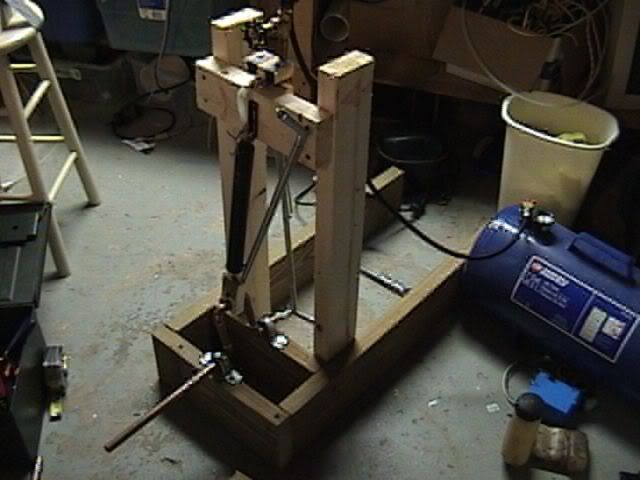
Details:
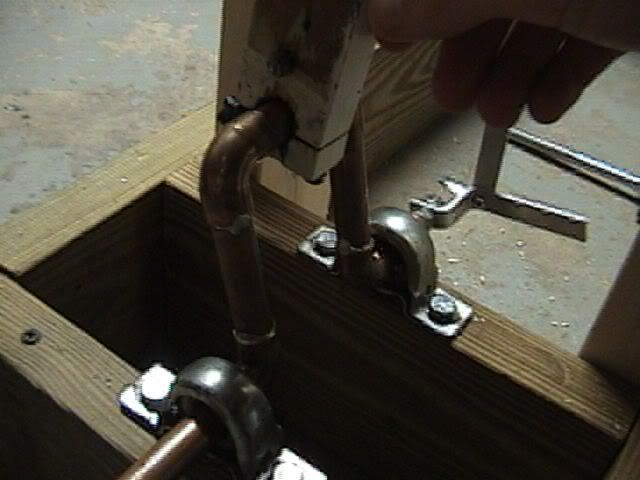
^ A closeup of the crankshaft, fashoned from 1/2 inch copper piping and fittings soldered together and mounted on 2 pillow blocks. You can see the peice of wood that connects the piston rod to the crankshaft.
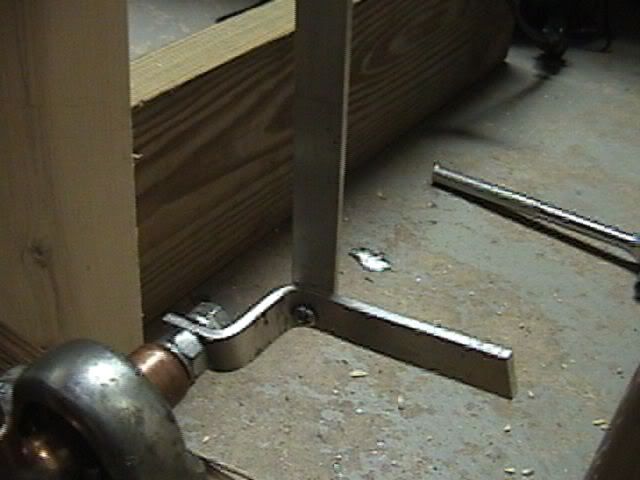
^ Here you can see the valve actuating arm, bolted onto the end of the crankshaft. The use of a 1/4" bolt allows me to fine tune the timing for optimum performance.
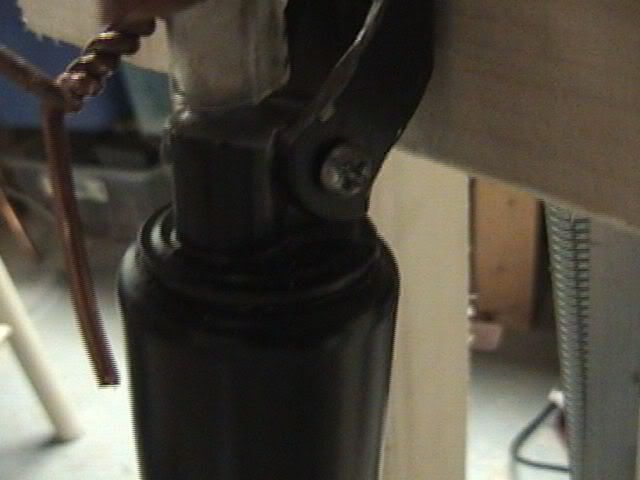
^ This is the top of the cylnder and piston, a modified screen door closer. I removed the internal spring and used JB weld to attach a peice of 1/4" copper tubing in the former ajustment screw hole, now its the steam port. I used the inculded mounting bracket that came with the cylinder and a single screw to attach it to the top support, that way, as the crank turns around the cylinder can follow it.
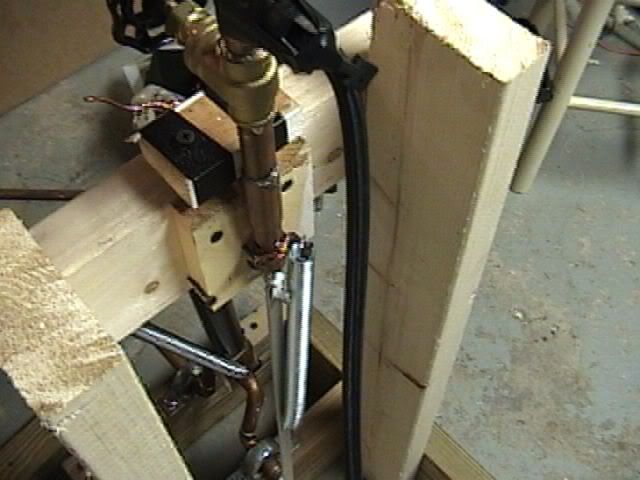
^ Here's the main valve. It is just a peice of copper pipe pushed all the way through a T fitting (had to grind down the inside of the fitting, that was a hellish job). Inside the tube there is a peice of allthread and a couple washers and an O ring that make up a piston that covers a hole in the pipe at the T. The piston moves up and down to expose the hole to either the steam source or the atmosphere. One major flaw of this design, as I soon found out, the steam will force the valve piston down, effectively stalling the crankshaft on part of the throw. The internal springs in the valve aren't enugh to counteract the forces, so I added an additional spring to the linkage to relive the pressure on the crankshaft.
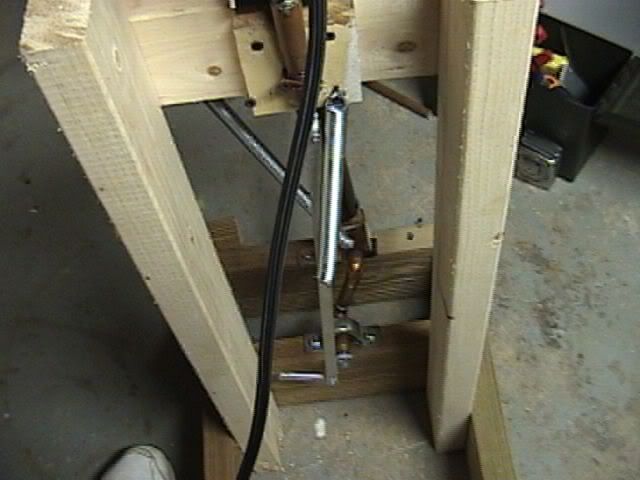
^ From this angle, you can see the spring I added to the valve linkage and the rear of the engine.
The engine is not yet complete, nor does it run on steam yet. I plan to build a boiler onto the back end of the frame. I also need a flywheel, as of now, i need to manually rotate the crank past certain dead spots in its action, as seen on the video.
Stay tuned for updates. |
Edited by - cirvin on Aug 26 2006 2:13:58 PM |
|
|
marks256
Mad Scientist
   
USA
402 Posts |
 Posted - Aug 26 2006 : 2:09:39 PM Posted - Aug 26 2006 : 2:09:39 PM


|
That thing looks great! Hmm, i think i am going to go out in the shop, see what i can do! Oh, you may want to fix the link to the video. I am going to try to copy and past right now, but it is still a pain.  |
Intel: We put the 'Um...' in Pentium! |
 |
|
|
Aaron Cake
Administrator
    
Canada
6718 Posts |
 Posted - Aug 28 2006 : 09:52:18 AM Posted - Aug 28 2006 : 09:52:18 AM





|
That's awesome! I've always loved steam power...There's just something about a 20 tonne locomotive powering up a hill that gets me all excited...It's an external machine, you can see all it's parts and instantly know how it works...
Once you get a flywheel on that it should run pretty well. PLEASE be VERY careful about making a boiler. If you can, find one that is already made and has been certified. Steam explosions suck... |
 |
|
|
Binary 1011001101
Nobel Prize Winner
    
United Kingdom
569 Posts |
 Posted - Aug 28 2006 : 11:39:28 AM Posted - Aug 28 2006 : 11:39:28 AM


|
| Nice!!! Can it turn without you having to turn it?? |
 |
|
|
cirvin
Nobel Prize Winner
    
USA
1542 Posts |
 Posted - Aug 28 2006 : 2:54:05 PM Posted - Aug 28 2006 : 2:54:05 PM



|
Not as of yet, that's what the flywheel is for.
As for the boiler, I'm not quite sure what I'm going to do. Flashtube boilers are relatively safe in that they don't have very much working fluid in them at one time, but they need an external water pump to keep them from running dry and scorching. I considered using an unmodified propane cylinder over burner, but I fear that it cannot generate the volume of steam I need.
The design that I'm leaning furthest to is a water tube style boiler where I would take an air tank, like the one shown in the pictures, drill 2 holes in the bottom and braze in a copper ladder like structure that the water can flow into that goes beneath the tank. That way there's lots of surface area for heat transfer, but I still have a good deal of water in the system so I won't need a pump. I can also make the device fail in the copper ladder which seems a bit safer to me.
Ideas are still knocking around, but with my financial position and school starting up again this engine is going to be running off air pressure for a while.
And yes, steam FTW! |
Edited by - cirvin on Aug 28 2006 2:54:56 PM |
 |
|
|
cirvin
Nobel Prize Winner
    
USA
1542 Posts |
|
|
Aaron Cake
Administrator
    
Canada
6718 Posts |
 Posted - Aug 29 2006 : 10:14:19 AM Posted - Aug 29 2006 : 10:14:19 AM





|
| That is so cool...Great job. |
 |
|
|
Schleusner
Member
 
USA
47 Posts |
 Posted - Aug 29 2006 : 10:29:29 AM Posted - Aug 29 2006 : 10:29:29 AM


|
| Couldn't you just build it like the old style boiler? If I understand correct, what they used to do was run some of the steam out through a pipe, and connect that to the water line going in, kinda like a siphon hose. |
 |
|
|
cirvin
Nobel Prize Winner
    
USA
1542 Posts |
 Posted - Aug 29 2006 : 1:42:27 PM Posted - Aug 29 2006 : 1:42:27 PM



|
I haven't heard of that, can you post a link?
From what you said, I dont think it can work since to inject new water, it needs to be put in with more pressure than what's currently in the boiler.
Methinks a horozontal watertube boiler will be sufficient. |
 |
|
| |
 Topic Topic  |
|

